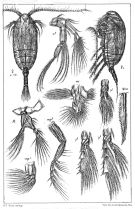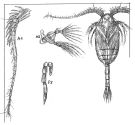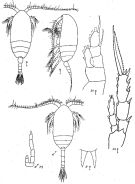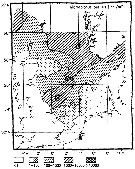|
|
 |
Fiche d'espèce de Copépode |
|
|
Calanoida ( Ordre ) |
|
|
|
Clausocalanoidea ( Superfamille ) |
|
|
|
Clausocalanidae ( Famille ) |
|
|
|
Microcalanus ( Genre ) |
|
|
| |
Microcalanus pusillus Sars, 1903 (F,M) | |
| | | | | | | Syn.: | ? Microcalanus sp. Farran, 1908 b (p.28, Rem.);
Microcalanus pygmaeus pusillus : Farran & Vervoort, 1951 e (n°37, p.3, figs.F);
? Microcalanus pygmaeus: Farran, 1926 (p.242, Rem.) | | | | Ref.: | | | Sars, 1903 (p.156, figs.F,M); Wolfenden, 1908 (p.41, fig.F, Rem.); 1911 (p.286); Lysholm, 1913 (p.5); With, 1915 (p.68, Rem.); Farran, 1920 (p.16, 21); Campbell, 1929 (p.310); Rose, 1933 a (p.80, figs.F,M); Farran, 1936 (p.406); Brodsky, 1950 (1967) (p.117, figs.F,M); Wiborg, 1954 (p.131, Rem.); 1955 (p.38, Rem.); Tanaka, 1956 c (p.386, Rem.); Vervoort, 1957 (p.36, Rem.); Tanaka, 1960 (p.35); Fagetti, 1962 (p.15); Shih & al., 1971 (p.44, 150); Chen & Zhang, 1974 (p.103, 112, figs.F); Kos, 1976 (Vol. II, figs.F, M); Brodsky & al., 1983 (p.228, figs.F,M); Bradford-Grieve, 1994 (p.130, figs.M, Rem); Boxshall & Halsey, 2004 (p.93: fig.M) |  issued from : G.O. Sars in An Account of the Crustacea of Norway. Vol. IV. Copepoda Calanoida. Published by the Bergen Museum, 1903. [suppl. Pl.II]. Female.
|
 issued from : G.O. Sars in An Account of the Crustacea of Norway. Vol. IV. Copepoda Calanoida. Published by the Bergen Museum, 1903. [suppl. Pl.III]. Male.
|
 issued from : K.A. Brodsky, N.V. Vyshkvartzeva, M.S. Kos & E.L. Markhaseva in Opred Fauna SSSR, 1983, 135. [p.227, Fig.107]. Female: R, rostrum; P1; P4. After Brodsky (1967, p.116) from N Pacif. Other drawings from Sars (1903).
|
 issued from : Q.-c. Chen & S.-z. Zhang in Studia Marina Sinica, 1974, 9. [Pl.8, Figs.100-103]. Female (from South China Sea): 100, habitus (dorsal); 101, urosome (lateral right side): 102, P1; 103, P2.
|
 issued from : J.M. Bradford-Grieve in The Marine Fauna of New Zealand: Pelagic Calanoid Copepoda. National Institute of Water and Atmospheric Research (NIWA). New Zealand Oceanographic Institute Memoir, 102, 1994. [p.130, Fig.75, D, E]. From Sars, 1903. Male: D, habitus (dorsal); E, P5.
| | | | | Ref. compl.: | | | Damas & Koefoed, 1907 (p.411, tab.II); Wilson, 1942 a (p.194); Sewell, 1948 (p.395, 555, 559, 566); Østvedt, 1955 (p.48: Rem., Table 15); Grice, 1963 a (p.495); Furuhashi, 1966 a (p.295, vertical distribution in Kuroshio region, Table 10); Matthews, 1967 (p.159, Table 1, Rem.); Peterson & Miller, 1975 (p.642, 650, Table 3, interannual abundance); 1976 (p.14, Table 1, 2, 3, abundance vs interannual variations); 1977 (p.717, Table 1, seasonal occurrence); Falconetti & Seguin, 1977 (p.188); Buchanan & Sekerak, 1982 (p.41, vertical distribution, Rem.: p.47); Kovalev & Schmeleva, 1982 (p.83); Hernroth, 1983 (p.835, Rem.: p.840); Tremblay & Anderson, 1984 (p.6); Mikhailovsky, 1986 (p.83, Table 1, ecological modelling); ; Sameoto & al., 1986 (p.53); Fransz & al., 1991 (p.6); Shih & Marhue, 1991 (tab.2, 3); Norrbin, 1991 (P;421, life history, gonad maturation); 1993 (p.204); Richter, 1994 (tab.4.1a); Shih & Young, 1995 (p.72); Krause & al., 1995 (p.81, Fig.12, abundance, Rem.: p.129); Titelmann & Tiselius, 1998 (343, table 1); Halvorsen & Tande, 1999 (p.279, figs.2, 3, 6); B.W. Hansen & al., 1999 (p.233, seasonal abundance & biomass); Razouls & al., 2000 (p.343, tab. 5, Appendix); Holmes, 2001 (p.43, Rem.); Fransz & Gonzalez, 2001 (p.255, tab.1); Sameoto & al., 2002 (p.13); Uysal & al., 2002 (p.17, tab.1); Bode & al., 2003 (p.85, Table 1, abundance); Peterson & Keister, 2003 (p.2499, interannual variability); Keister & Peterson, 2003 (p.341, Table 1, 2, abundance, cluster species vs hydrological events); Manning & Bucklin, 2005 (p.233, Table 1); Hooff & Peterson, 2006 (p.2610); Hop & al., 2006 (p.182, Table 4); Durbin & Casas, 2006 (p.2537, Table 2a); Valdés & al., 2007 (p.103: tab.1); Humphrey, 2008 (p.84: Appendix A); Raybaud & al., 2008 (p.1765, Table A1); Peterson, 2009 (p.73, Rem.: p 78); Galbraith, 2009 (pers. comm.); Dvoretsky & Dvoretsky, 2009 a (p.11, Table 2, abundance); 2010 (p.991, Table 2); 2011 a (p.1231, Table 2: abundance, biomass); 2011 b (p.469, Table A, abundance, biomass); Kosobokova & al., 2011 (p.29, Table 2, Rem.: Arctic Basins); Pomerleau & al., 2011 (p.1779, Table III); Selifonova, 2011 a (p.77, Table 1, alien species in Black Sea); Shiganova & al., 2012 (p.61, Table 4); DiBacco & al., 2012 (p.483, Table S1, ballast water transport); Sigurdardottir, 2012 (p.1, Table 2.3); Dvoretsky & Dvoretsky, 2012 (p.1321, Table 2, 3, 4, 5, abundance, biomass, production); Takahashi M. & al., 2012 (p.393, Table 2, water type index); in CalCOFI regional list (MDO, Nov. 2013; M. Ohman, comm. pers.); Dvoretsky & Dvoretsky, 2013 a (p.205, Table 2, % abundance); El Arraj & al., 2017 (p.272, table 2); Belmonte, 2018 (p.273, Table I: Italian zones); Acha & al., 2020 (p.1, Table 3: occurrence % vs ecoregions). | | | | NZ: | 15 | | |
|
Carte de distribution de Microcalanus pusillus par zones géographiques
|
| | | | | | | | | | | |  Issued from : M. Krause, J.W. Dippner & J. Beil in Prog. Oceanog., 1995, 35. [p.99, Fig.12]. Issued from : M. Krause, J.W. Dippner & J. Beil in Prog. Oceanog., 1995, 35. [p.99, Fig.12].
Horizontal distribution pattern of Microcalanus pusillus (individuals per m2) in the winter North Sea.
Collected by WP2-net. Numbers (ind/m3) depth-integrated, extrapoled to the bottom (but at a maximum to a depth of 500 m) and expressed as ind per m2 of water surface. |
| | | | Loc: | | | Antarct. (Indian: continent, Mc Murdo), Caribbean, G. of Mexico, NW Atlant., G. of Maine, Georges Bank, Fundy Bay, off E Nova Scotia, off Newfoundland, Baffin (Lancaster Sound, W Baffin Bay), Greenland Sea, Iceland, Fram Strait, Norwegian Sea, Norway, Raunefjorden: all the year, Nordvestbanken, Balsfjorden, Kongsfjorden, Spitzberg, Barents Sea, Pechora Sea, Franz Josef Land, Arctic (Nansen, Amundsen, Makarov, Canada Basins), Barents Sea, North Sea, Gullmar Fjord, Lübeck Bay, off W Ireland, Maroccan coast, W Spain (Ria de Arosa), off Coruña, Bay of Biscay, Medit. (W Basin, Tyrrhenian Sea, Lebanon Basin, Black Sea), China Seas (South China Sea), E Japan (Bösö region) Japan Sea, Okhotsk Sea, Bering Sea, Station "P", British Columbia, off Washington coast, Oregon (Yaquina, off Newport), California, Chile | | | | N: | 81 | | | | Lg.: | | | (32) F: 0,6; ? (38) F: 0,72-0,7; (65) F: ± 0,7; M: ± 0,7; (131) F: 0,7-0,6; M: 0,7; (338) F: 0,7-0,68; (376) F: 0,67-0,63; {F: 0,60-0,70; M: 0,70} | | | | Rem.: | Sampling depth (Antarct.) : 0-350 m.
Il est possible que cette forme ne soit qu’une variante de Microcalanus pygmaeus. Pour Vives & Shmeleva (2007, p.635), l'espèce citée par Valdés (1993) serait Microcalanus pygmaeus.
Voir aussi les remarques en anglais | | | Dernière mise à jour : 25/10/2022 | |
|
|
 Toute utilisation de ce site pour une publication sera mentionnée avec la référence suivante : Toute utilisation de ce site pour une publication sera mentionnée avec la référence suivante :
Razouls C., Desreumaux N., Kouwenberg J. et de Bovée F., 2005-2025. - Biodiversité des Copépodes planctoniques marins (morphologie, répartition géographique et données biologiques). Sorbonne Université, CNRS. Disponible sur http://copepodes.obs-banyuls.fr [Accédé le 28 décembre 2025] © copyright 2005-2025 Sorbonne Université, CNRS
|
|
 |
 |









